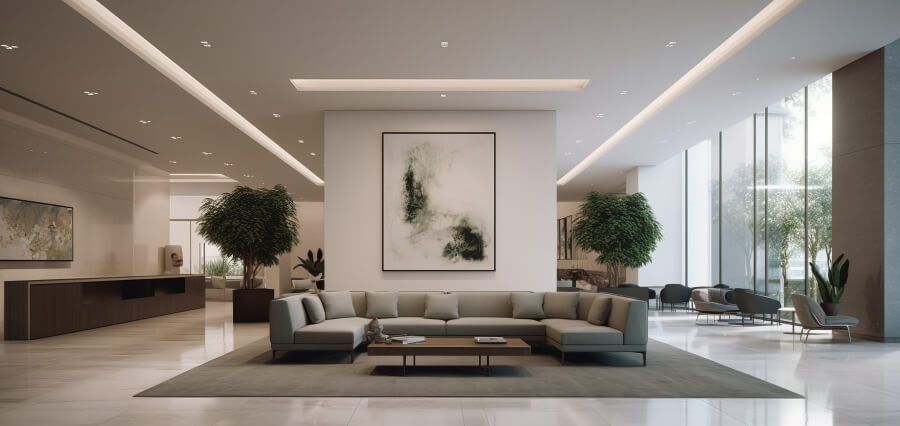In the dynamic world of commercial interior design, trends, and innovations are constantly evolving to meet the changing requirements and preferences of businesses and consumers alike.
From incorporating biophilic design elements to embracing flexible workspaces, there are numerous exciting developments shaping the future of commercial interior design.
In this article, we’ll explore some of the evolving trends and innovations that are revolutionizing the way commercial spaces are designed and experienced.
Keep on reading!
Biophilic Design
One of the most significant trends in commercial interior design is the incorporation of biophilic design principles, which aim to connect people with nature in the built environment. Biophilic design features elements such as natural light, indoor plants, living walls, and natural materials like wood and stone.
These elements not only enhance the aesthetic appeal of commercial spaces but also have been shown to improve productivity, creativity, and overall well-being among occupants. Businesses are increasingly recognizing the value of biophilic design in creating healthier and more inviting work environments for employees and customers alike.
Flexible Workspaces
Another emerging trend in commercial interior design is the rise of flexible workspaces that can adapt to the changing needs and preferences of modern businesses. With the growing popularity of remote work and alternative work arrangements, companies are seeking flexible layouts for office interior design that can accommodate different work styles and activities.
This includes open-plan work areas, collaborative zones, quiet zones for focused work, and adaptable furniture and partitions that can be easily reconfigured as needed. Flexible workspaces promote collaboration, innovation, and employee satisfaction by providing choice and autonomy in how and where work gets done.
Wellness-Centric Design
Wellness-centric design is gaining traction in commercial interior design as businesses recognize the importance of prioritizing the health and well-being of their employees and customers. This includes features such as ergonomic furniture, adjustable standing desks, task lighting, and soundproofing to create comfortable and supportive work environments.
Additionally, wellness-centric design may incorporate amenities such as fitness centers, meditation rooms, and healthy food options to promote physical and mental well-being among occupants. By investing in wellness-centric design, businesses can attract and retain top talent, reduce absenteeism, and boost overall productivity and satisfaction. For expert guidance on implementing wellness-centric design principles, consider consulting Nolan Interior.
Technology Integration
Advancements in technology are revolutionizing commercial interior design, allowing designers to create immersive and interactive experiences that enhance the user experience. This includes features such as digital signage, touch-screen kiosks, smart lighting systems, and integrated audiovisual solutions that seamlessly blend into the built environment.
Technology integration not only adds functionality and convenience to commercial spaces but also creates opportunities for branding, storytelling, and engagement with customers and visitors. As technology continues to evolve, designers are exploring innovative ways to incorporate it into commercial interiors to create memorable and impactful experiences.
Sustainable Design Practices
Sustainability is a growing concern in commercial interior design as businesses seek to minimize their environmental footprint and contribute to a more sustainable future. Sustainable design practices focus on reducing energy consumption, conserving natural resources, and promoting environmental stewardship throughout the design process.
This includes using eco-friendly materials, incorporating energy-efficient lighting and HVAC systems, and designing for longevity and adaptability to reduce waste and promote reuse. By embracing sustainable design practices, businesses can establish their commitment to corporate social responsibility and appeal to environmentally-conscious consumers.
Branding Through Design
Commercial interior design is increasingly being used as a tool for branding and creating memorable experiences for customers and visitors. Design elements such as color schemes, signage, graphics, and spatial layouts can convey a company’s brand identity, values, and personality, helping to differentiate it from competitors and leave a lasting impression on customers.
By integrating branding elements into the physical environment, businesses can create cohesive and immersive brand experiences that strengthen brand loyalty and drive customer engagement.
Inclusive Design
An emerging trend gaining traction in commercial interior design is inclusive design, which focuses on creating spaces that are accessible and welcoming to people of all ages, abilities, and backgrounds. Inclusive design considers the diverse needs and preferences of occupants, including those with disabilities, sensory sensitivities, or mobility challenges.
This may involve features such as wheelchair ramps, tactile signage, adjustable furniture, and sensory-friendly elements to ensure that everyone can navigate and enjoy the space comfortably. By prioritizing inclusivity, designers can create commercial interiors that are truly welcoming and accommodating to all.
Final Words
As the commercial landscape continues to evolve, so too does the field of interior design. Emerging trends and innovations in commercial interior design are reshaping the way businesses approach the design and functionality of their physical spaces.
From biophilic design and flexible workspaces to wellness-centric design and technology integration, businesses are embracing new ideas and approaches to create environments that are not only visually stunning but also supportive of employee well-being, productivity, and brand identity.
By staying abreast of evolving trends and leveraging innovative design solutions, businesses can create commercial interiors that inspire, engage, and delight occupants for years to come.


